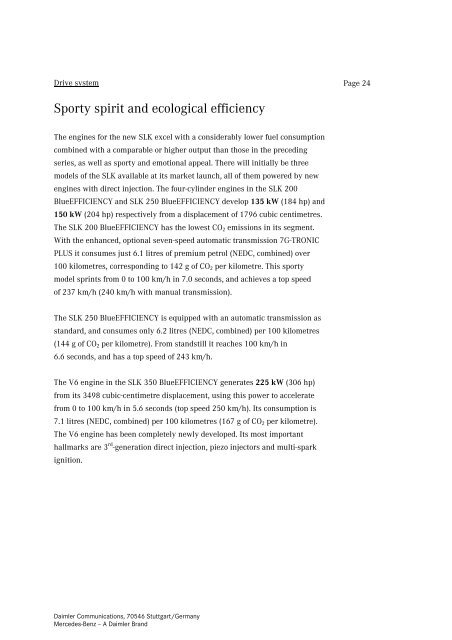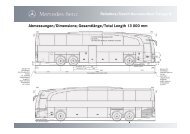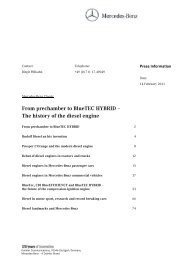The new Mercedes-Benz SLK: Passion meets efficiency - Daimler
The new Mercedes-Benz SLK: Passion meets efficiency - Daimler
The new Mercedes-Benz SLK: Passion meets efficiency - Daimler
You also want an ePaper? Increase the reach of your titles
YUMPU automatically turns print PDFs into web optimized ePapers that Google loves.
Drive systemPage 24Sporty spirit and ecological <strong>efficiency</strong><strong>The</strong> engines for the <strong>new</strong> <strong>SLK</strong> excel with a considerably lower fuel consumptioncombined with a comparable or higher output than those in the precedingseries, as well as sporty and emotional appeal. <strong>The</strong>re will initially be threemodels of the <strong>SLK</strong> available at its market launch, all of them powered by <strong>new</strong>engines with direct injection. <strong>The</strong> four-cylinder engines in the <strong>SLK</strong> 200BlueEFFICIENCY and <strong>SLK</strong> 250 BlueEFFICIENCY develop 135 kW (184 hp) and150 kW (204 hp) respectively from a displacement of 1796 cubic centimetres.<strong>The</strong> <strong>SLK</strong> 200 BlueEFFICIENCY has the lowest CO 2 emissions in its segment.With the enhanced, optional seven-speed automatic transmission 7G-TRONICPLUS it consumes just 6.1 litres of premium petrol (NEDC, combined) over100 kilometres, corresponding to 142 g of CO 2 per kilometre. This sportymodel sprints from 0 to 100 km/h in 7.0 seconds, and achieves a top speedof 237 km/h (240 km/h with manual transmission).<strong>The</strong> <strong>SLK</strong> 250 BlueEFFICIENCY is equipped with an automatic transmission asstandard, and consumes only 6.2 litres (NEDC, combined) per 100 kilometres(144 g of CO 2 per kilometre). From standstill it reaches 100 km/h in6.6 seconds, and has a top speed of 243 km/h.<strong>The</strong> V6 engine in the <strong>SLK</strong> 350 BlueEFFICIENCY generates 225 kW (306 hp)from its 3498 cubic-centimetre displacement, using this power to acceleratefrom 0 to 100 km/h in 5.6 seconds (top speed 250 km/h). Its consumption is7.1 litres (NEDC, combined) per 100 kilometres (167 g of CO 2 per kilometre).<strong>The</strong> V6 engine has been completely <strong>new</strong>ly developed. Its most importanthallmarks are 3 rd -generation direct injection, piezo injectors and multi-sparkignition.<strong>Daimler</strong> Communications, 70546 Stuttgart/Germany<strong>Mercedes</strong>-<strong>Benz</strong> – A <strong>Daimler</strong> Brand







